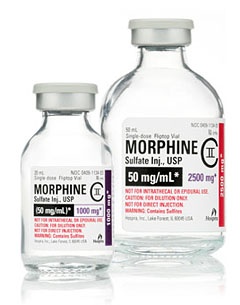
The FEI Bureau recently approved changes to the FEI Equine Prohibited Substance List for 2013, which will come into force on 1 January 2013. Among them are a few interesting alterations, most particularly Fentanyl and Morphine (analgesics), both of which are currently classified as Banned Substances.
These two products have been moved to the Controlled Medication section of the List, apparently due to their increasingly common legitimate use in equine medicine.
"Morphine is a licensed product and has therefore been moved into the Controlled Medication section of the List," says FEI Veterinary Director, Graeme Cooke.
However American veterinarian Tom Schell DVM says he is surprised by this amendment, due to the potency of the aforementioned drugs. "Morphine and Fentanyl are potent narcotic pain medications and are only used in hospital type settings for severe pain, or used more commonly to induce anesthesia during surgical procedures," says Dr Schell. "They are controlled medications here in the USA because they are addictive for humans and habit forming substances. They have no purpose or usefulness in the competition arena. They are used to induce anesthesia essentially so therefore would not benefit a horse that is competing and could actually prove detrimental if used due to safety reasons. They should be banned."
When asked why these two substances in particular were changed from a banned to a controlled substance, the FEI says that both "Fentanyl and Morphine are now licensed for veterinary use and therefore have a legitimate use in veterinary medicine. The two are usually administered for pain management, hence they now comply with the criteria to be a Controlled Medication," says Cooke.
Dr Schell, however, retorted that morphine is a narcotic analgesic used in human and veterinary medicine only to combat severe pain and that vets do not use morphine very commonly in equine veterinary medicine.
 "Morphine is only administered if it is absolutely needed, as it can cause extreme excitement and agitation unless a sedative is given along with it. Given the side effects of the medication and also considering that narcotics generally cause the patient to be uncoordinated, I am not sure why someone would want to use this medication as a performance enhancer. A vet would only have to use morphine or fentanyl for anesthesia cases for surgery or extreme levels of pain such as in laminitis, a fractured bone, or trauma. I have only used morphine once or twice in practice and did not like the way the horses responded to the medication, so have never used again."
"Morphine is only administered if it is absolutely needed, as it can cause extreme excitement and agitation unless a sedative is given along with it. Given the side effects of the medication and also considering that narcotics generally cause the patient to be uncoordinated, I am not sure why someone would want to use this medication as a performance enhancer. A vet would only have to use morphine or fentanyl for anesthesia cases for surgery or extreme levels of pain such as in laminitis, a fractured bone, or trauma. I have only used morphine once or twice in practice and did not like the way the horses responded to the medication, so have never used again."
There are no indications or reason to use either of these two medications in a competing animal, only in a hospitalized setting. After researching the recent FEI cases involving morphine, it seems that the drug was actually being detected in horse feeds and this could be the reason why the drug was being stripped of its ban.
"The FEI Legal Department has confirmed that none of the recent cases involving morphine have been dismissed, and in fact, the FEI Tribunal ordered two-year sanctions in both recent cases (BINGO, MOUSE). However they did find that morphine was present in some varieties of horse feed.”
The MOUSE case found that "British, Irish, and French manufacturing trade bodies for equine feed say it is impossible to eliminate the presence of naturally occurring prohibited Substances, (NOPS), amongst them Morphine, and it is only possible to reduce the respective risk". Despite a positive finding, experts in this case stated "that according to international literature, forage normally used for horses contained plants, which itself contained opiate alkaloids such as morphine".
"It appears that this is only an issue with horse feeds in Europe and is associated with potential contamination of the feeds with poppy seeds or opium poppy," says Dr Schell. "My assumption as to why morphine may have gone from banned to controlled is that it is present in some degree in horse feeds in Europe, which may cause horses to test positive. If it is 'banned', then no detectable level would be accepted, versus if it was 'controlled', then I am assuming that a certain blood level would be allowed due to consideration that the feed may be contaminated against the owner's knowledge.”
 However, when asked if morphine was made a controlled substance because in many tribunal cases it was found to naturally occur in horsefeed, the FEI did not draw the connection. It simply stated again that, "morphine is a licensed product and has therefore been moved into the Controlled Medication section of the List". Adding that "while the controlled substance category recognizes that certain medicines are commonly used in veterinary medicine, the FEI stresses that they must never be used during competition."
However, when asked if morphine was made a controlled substance because in many tribunal cases it was found to naturally occur in horsefeed, the FEI did not draw the connection. It simply stated again that, "morphine is a licensed product and has therefore been moved into the Controlled Medication section of the List". Adding that "while the controlled substance category recognizes that certain medicines are commonly used in veterinary medicine, the FEI stresses that they must never be used during competition."
The Federation is very happy with the evident success of its regulation guidelines and procedures. "Since the FEI started the transparent List approach to anti-doping the number of positive cases has dropped very dramatically. All major championships, including the 2010 World Equestrian Games , the Youth Olympic Games, and the London 2012 Olympic and Paralympic Games have been free of positive cases. This is a significant indicator of the success of the revised FEI approach to anti-doping and how the competitors and their advisors have fully embraced the FEI’s Clean Sport campaign."
by Sarah Warne
Photos © Astrid Appels - private
Related Link
2013 FEI Equine Prohibited Substances List in Effect from 1 January 2013